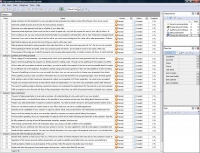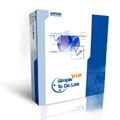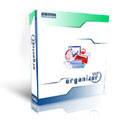|
Task Management Software |
 |
|
|
|
|
| |
|
 TESTIMONIALS TESTIMONIALS
|
|
"...This is an excellent program. I'm so glad that I stumbled on to this when researching for task management programs. Very low learning curv, quite flexible, and the price is right. Tried at least 20 other programs, either too complicated, too expensive, or poor documentation..."
Chad Lindsey -
Honolulu, HI
|
|
|
|
|
|
|
|
Sales process checklist |
|
|
|
|
|
|

 |
This sales process checklist will be helpful to any beginner salesmen or business owners who would like to adapt the best practices in their organizations. There is no strict formulation of steps, because this process requires much contribution of creative approach and personal experience, but there are general phases which, nevertheless, are not necessary for every case. This checklist gives all-round outline and recommendations on the common phases.
|
| Order 750 checklists in MS Word and PDF printable format at $49.99 USD only. |
BUY NOW!  |
General recommendations:
- You should continuously make analysis to know if it is efficiently organized.
- Perform periodical audits to know if it is correctly performed.
- Make assessment in terms of results, for this you need to establish good performance control to know where defections happen, to study cases to know backgrounds in each one, and record statistics.
- Train salesmen and continuously improve sales process to match your reality; you may ask for consulting from industry experts.
Prospecting and initiating contacts (doing cold calls):
- Make sure all salesmen have got appropriate training and are fully familiar with all aspects of the products and services they sell.
- Gather essential information on the prospects before calling them, as much as possible.
- Create “ideal customer” profile to be the criteria for appraising prospects.
- Clarify reasons for not pursuing some prospects and for better focusing on others.
- Range customers by their potential.You may use automation provided by some CRM software which can do a quick evaluating of prospects recorded in your database.
- Determine suitable products and services for each particular prospect.
- Determine your sales approach and plan a schedule of your sales calls.
- Determine primal objectives (whom would you like to reach to speak with, etc) and the purpose for each of your calls (to inform, to question, to make an appointment etc).
- Prior to making a call, you may communicate some information to a prospect by sending them a fax or mail. Preparatory message should be brief and related to prospect’s specifics.
- Determine if you want to close the sale on the first call or you want to put a background for a later call or sales presentation. Outline a brief strategy for each case.
- Right before making a call, ensure that everything you need is within easy reach.
- Make prospects interested by asking questions that make them think, or that cannot be answered with “no”. Do not run into a product presentation right from the jump.
- When speaking be friendly and polite. State your purpose quickly and clearly, do not speak to much or too quickly. Make your statements build trust and rapport, use humor.
- The purposes of this stage are to identify prospects with promising sales opportunities, to initiate contacts with them, to catch and hold their attention.
Qualifying and making proposals:
- This is a stage of mutual assessing – you assess profits which can be potentially made and costs associated with the customer opportunity, while customer decides if your company can satisfy their needs.
- Keep in mind that qualifying the prospect is a defining moment in making a sale. Through correct qualifying of the prospect you define your further approach and activities.
- When a sales call conversation is started up and kept, you need to qualify the prospect to find out as much as possible about his needs and wants.
- Do not fall back with a first objection, if prospect is already using some product get know if they are fully satisfied or is there anything they want to better.
- The point of qualifying is to know how you can satisfy the client, how you can convince him to choose your proposition from others, probably to find some “hot buttons”.
- When qualifying a person, base yourself on information that you have learned before (on prospecting stage). Have all needs agreed with the customer.
- After getting a vision of client needs and requirements, adjust your proposition to fit them reasonably. You need to give a prospect some good business reasons to buy.
- Propose your products and services to meet client’s needs and expectations, in a way when your proposition sounds really attractive and worth of consideration.
- The result of qualifying stage is obtaining a potential customer who expressed the need/interest for the products or services proposed by the seller.
- Offer a prospect to move forward with face-to-face presentation where they can clarify all practical moments. Schedule your customer visit to be convenient to the customer.
Sales presentation:
- The point of sales presentation is to provide a customer with understanding why he would want to own your product.
- During presentation, you should focus rather on the benefits of your products and services, than telling about features and other qualitative or quantitative characteristics.
- Prepare your sales presentation in regard to customer’s specifics. You need to present and prove some good business reasons to buy your product.
- When you visit client’s location or he/she comes to your office, make sure you have a credible appearance.
- Describe proven capabilities of your company in regard to client’s needs, and provide him/her with testimonials and references from satisfied customers.
- Keep in mind that making the sale is your secondary objective, because your primary goal is helping the prospect.
- Avoid excessive speaking, focus your presentation on aspects which can be really interesting and important to the customer. Keep the most delicious things up to the ending part of presentation.
- Be fully prepared by having at hand all demonstration materials, samples, brochures etc.
- While making a presentation shine with enthusiasm about your product. Be fully confident of its capabilities.
- Make sure that you contribute more than just your product or service. You may supplement it with all-round support, consultation and business advice as a part of your offer.
- Handle all client questions correctly. You may have friendly discussion, but never argue with prospects, and never try to confuse them. Just acknowledge customer's doubt and state a solution to cover it. If any confusion appears, clarify it immediately.
Closing the Sale and Sale follow up:
- Identify that customer is ready to buy from you. There are a number of indirect indicators which may tell you that customer is ready to give you a positive answer. If customer hesitates, then identify why. Handle objections correctly.
- Negotiate to find common grounds. Before presentation you need to predefine some fields where you can give up something to persuade unyielding prospect (for example discount you can give, some service that can be presented to client for free).
- Handle questions related to practical aspects of the purchase. Make the payment maximally easy to be done.
- Explain and start the program of post-sale support and services – make a client feel fully serviced.
- Register payment and deliver goods. Remunerate salesperson with proper wage.
- Support client with powerful sales follow up to ensure impossibility of money-back.
| Order 750 checklists in MS Word and PDF printable format at $49.99 USD only. |
BUY NOW!  |
|





 |
CentriQS Tasks Management Solution 
Looking for multi-user task management software? Try CentriQS complete task management solution for planning, tracking and reporting tasks, projects, and schedules. Increase productivity of your small business or office by better organizing your employees' tasks and time.
 FREE Download CentriQS FREE Download CentriQS
|
|
|
|
|
|
|
|
|
|
CentriQS  -15% OFF -15% OFF |
All-in-one business management software
for small and midsize enterprises |
 |
|
|
| VIP Task Manager |
Multi-user project management software
to plan, schedule and track project tasks. |
 |
|
|
| VIP Checklists
|
More than 750 ready-to-use to-do lists
to plan your personal and business life |
 |
|
|
| VIP Team To Do List |
Professional task management software
to make and send team todo lists by email |
 |
|
|
| VIP Organizer |
Personal time management software
to organize time at home and at work |
 |
|
|
| VIP Simple To Do List
|
Simple and effective to-do list software
to plan daily chores, trips, wedding, etc. |
 |
|
|
|
|
|
|
|